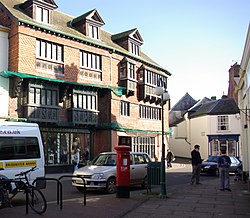King's Castle, Wiveliscombe
Hill forts in SomersetScheduled monuments in Taunton DeneSomerset geography stubsWiveliscombe

King's Castle is an Iron Age Hillfort 1 kilometre (0.62 mi) east of Wiveliscombe in Somerset, England. It is surrounded by two banks with a ditch between them. The inner wall ranges up to 2.5 metres (8.2 ft) high and the outer wall gets up to 1.5 metres (4.9 ft) high. Arrowheads, scrapers, and borers from as far back as the Neolithic period have been found at the site. A coin hoard of 1139 coins was found in a pot buried 0.30 metres (1 ft) deep.The site has been heavily damaged by repeated quarrying and ploughing.
Excerpt from the Wikipedia article King's Castle, Wiveliscombe (License: CC BY-SA 3.0, Authors, Images).King's Castle, Wiveliscombe
Castle Lane,
Geographical coordinates (GPS) Address External links Nearby Places Show on map
Geographical coordinates (GPS)
| Latitude | Longitude |
|---|---|
| N 51.046027777778 ° | E -3.2895166666667 ° |
Address
King's Castle
Castle Lane
TA4 2TP
England, United Kingdom
Open on Google Maps







